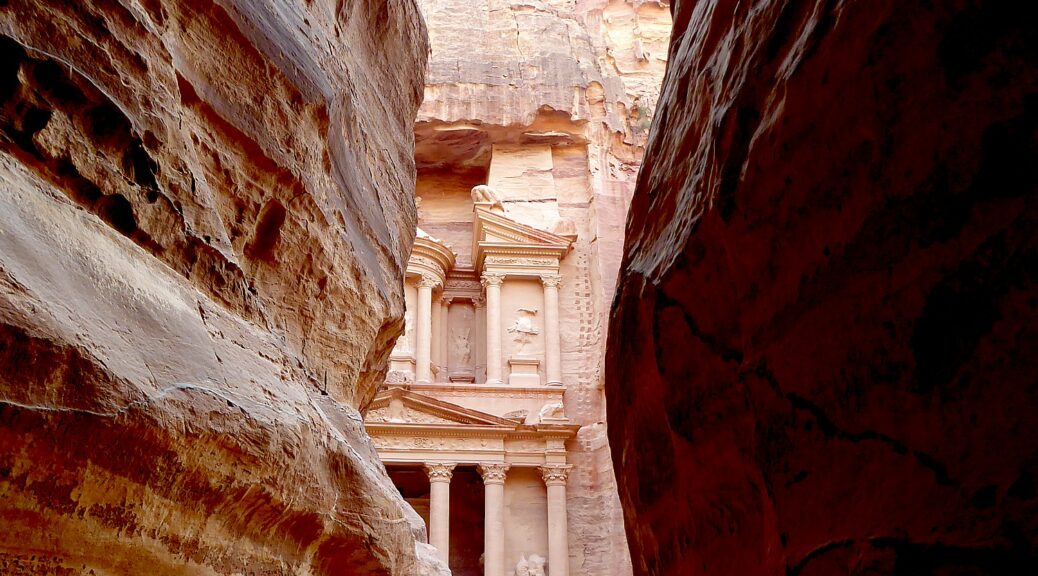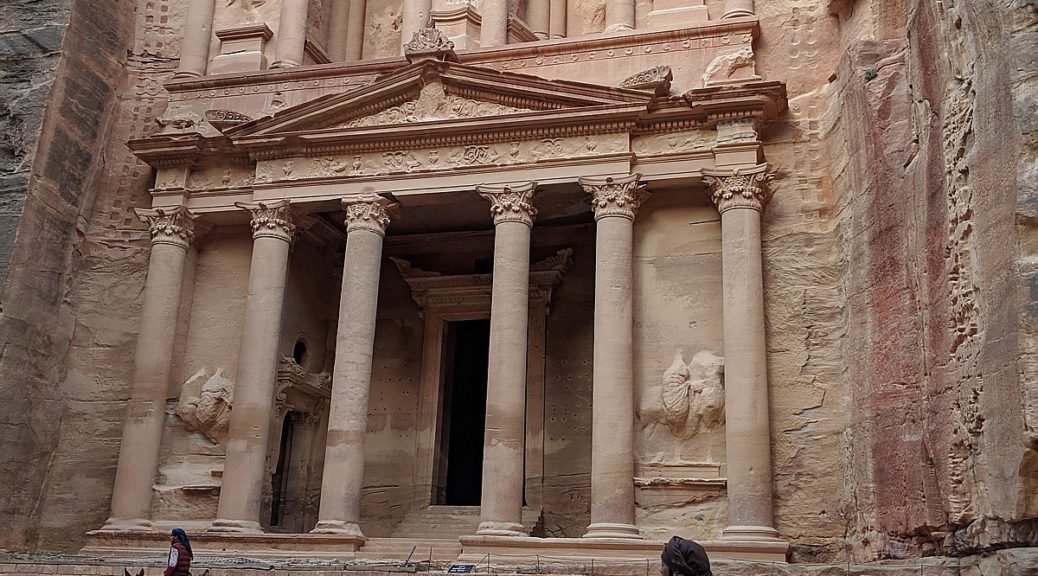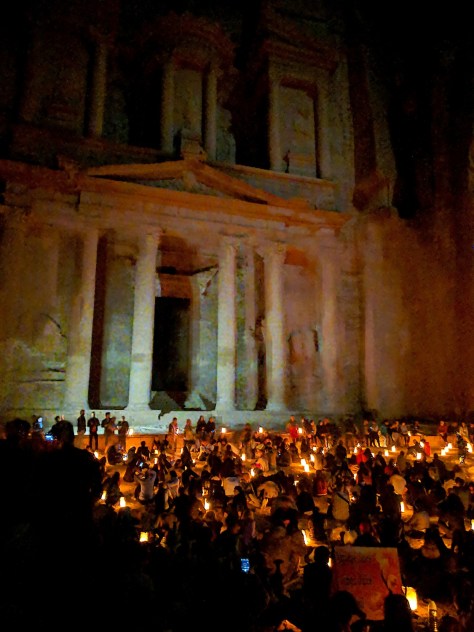
By Karen Rubin, Travel Features Syndicate, goingplacesfarandnear.com
At the start of Leg 6 of the Global Scavenger Hunt in Amman, Jordan, only four of the original 10 teams competing are still in contention to win, so several of the teams can now join together, use their cell phones for planning and booking, get help from the hotel concierge, and be generally unrestricted by the rules but still enthralled by the challenges of the scavenges.
But for those competing, some of the mandatory challenges pose a difficult puzzle to achieve in terms of logistics and timing. The one that proves problematic requires the team to travel one way to or from Petra along the ancient Kings Highway – the problem is that the Jett Express Bus doesn’t take that route and the rules don’t allow a taxi from outside the city. Hearing how the two top teams surmount the challenge is quite interesting.
We arrive at our five-star hotel, the Amman W, have our meeting and get our booklet with the scavenges, and a bunch of us (no longer competing) pack into a taxi to visit an ancient Roman amphitheater built during the time of Antenios Pius in 138-161 AD. We cross the street to a local restaurant, where we enjoy a meal of rotisserie chicken served with rice, and get a sense of this ancient city.
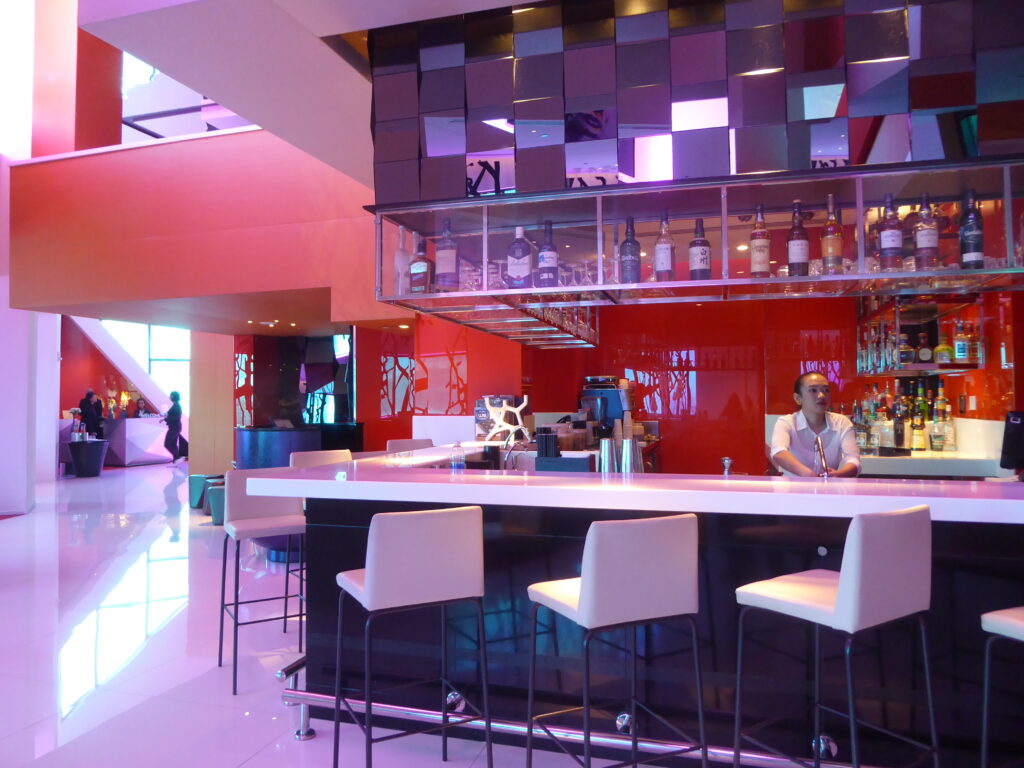
Whereas Abu Dhabi seemed unreal in many respects – a modern invention, manufactured even – Amman, the capital of Jordan, is very real and reflects its age as an early city. Jordan is where one of the largest Neolithic settlements (c. 6500 BC) ever discovered in the Middle East exists; Citadel Hill contains early Bronze Age tombs (3300-1200 BC). By the beginning of the Iron Age, Amman had become the capital of the Ammonites, referred to in the Bible as Rabbath-Ammon (“rabbath” means capital, or “king’s quarters”). We can look out from the high floors of the hotel to the hillsides crammed with houses and imagine what it might have looked like.
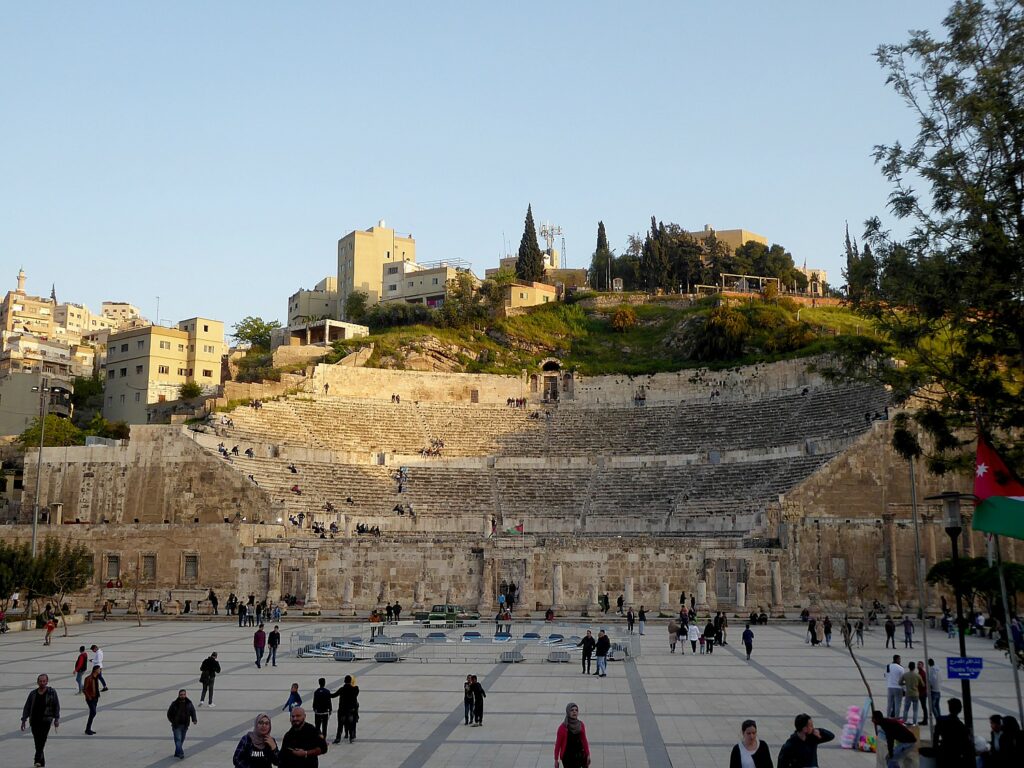
All but one team is intent on going to Petra, but have chosen various means to get there. I find myself on the 6:35 a.m. Jett Express Bus with three of the teams, including one that is in second place in the Global Scavenger Hunt, only a point behind the leader. Five others (including my teammate) hired a car and driver (allowed because none of them were competing), and Bill Chalmers, the ringmaster of GSH, Pamela and teenage son Luka are traveling separately. Each of us leaves at a different time by a different conveyance. But what a surprise! We all wind up at the same mid-way trading post at the same time. Hugs all around.
Struck for decades by the Frederic Church painting of Petra, and then by hearing a New York Times Travel Show talk about “Petra at Night,” I decide to arrange my own overnight stay so I don’t have to rush back. I learn that the Petra at night is only offered twice weekly and am lucky enough to be there for a Wednesday. I hastily consult hotels.com for a hotel – none available under $200/night. I check booking.com and find a hotel – more of a hostel, really – at a very affordable price, less than a mile from the entrance to Petra. “Only one room left” the site warns. And considering how so many of the hotels were booked, I take the leap and book it within seconds.
The concierge has reserved the seats on the Jett bus for the morning, with the return the next day (only one departure each way/daily), at 5 p.m.
Rose-Red Ancient City of Petra
We travel 240 km south from Amman (120 km north of the Red Sea city of Aqaba – the trip through the countryside is interesting – the vast emptiness, the sand, flocks of animals. Wind turbines!

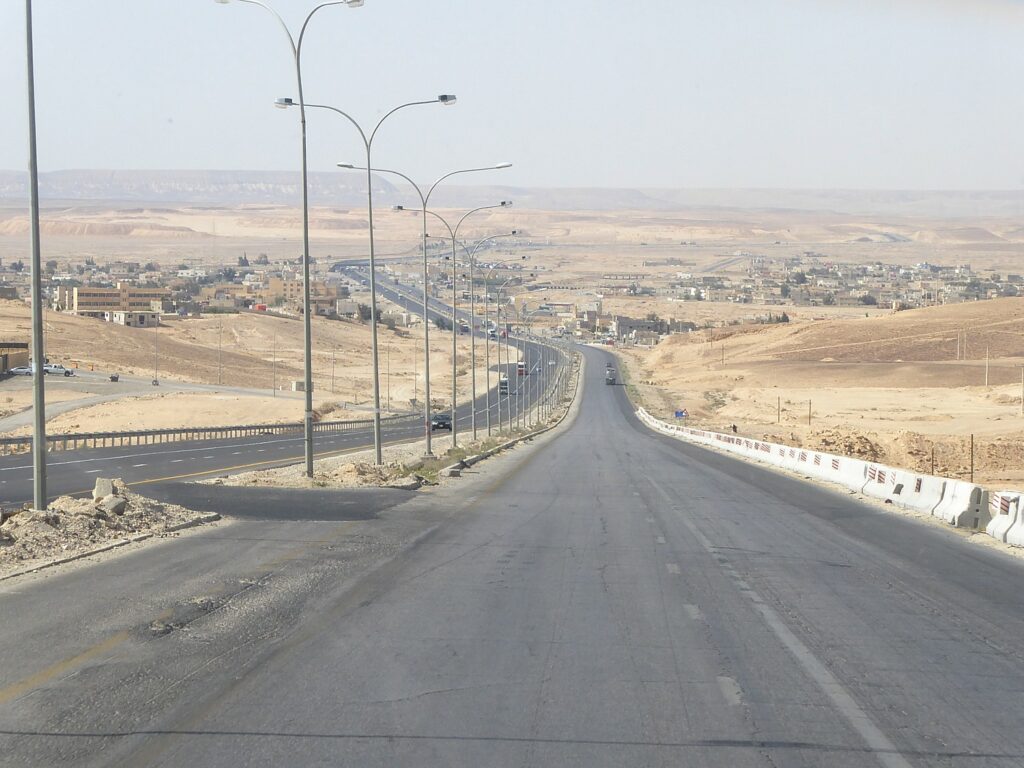
The bus – which is an hour late in departing because the company has put on a second bus to accommodate all the passengers – arrives at the Petra bus station next door to the entrance to the archeological site at around 11 am.
I use our Jordan Pass (which Chalmers had obtained in advance, providing pre-paid admission to most archaeological sites, including two consecutive days at Petra, along with the visa) for the day’s admission and buy the ticket for Petra at Night ($25).
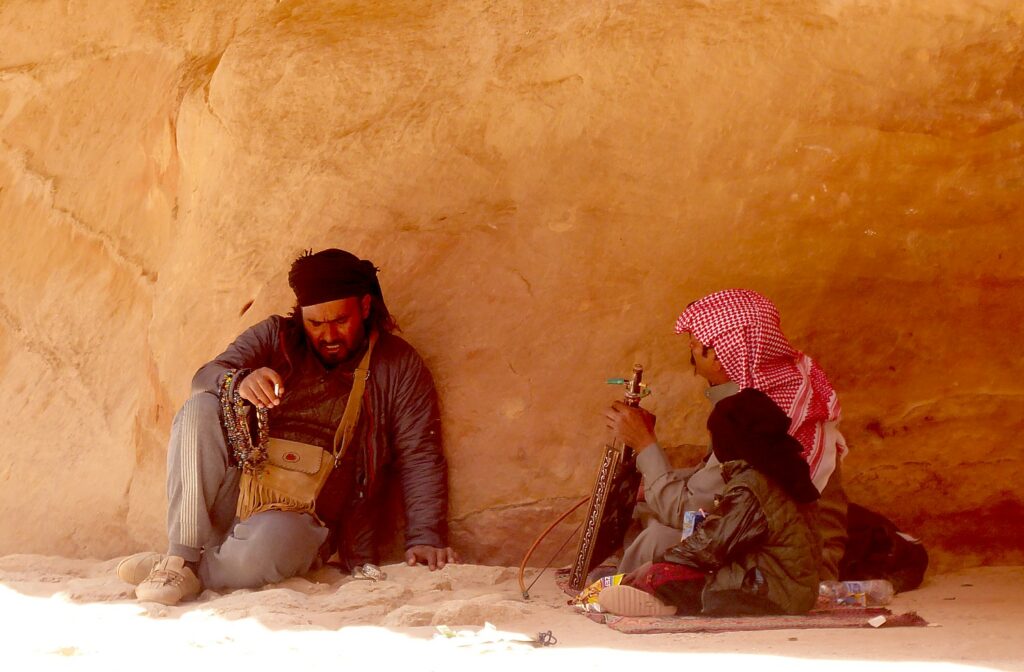
While the others have to move hastily through Petra – in fact, they don’t even get as far as the Treasury (so what is the point of coming at all?), I am able to move as slowly and contemplatively as I want, immersing myself in the scenes and the details, knowing I will return in the evening and the next day.

I am amazed by Petra. That now-iconic view of the Church painting (and Indiana Jones movie) that comes into focus as you walk through the cavern (known as the Siq) with the most beautiful striations and shapes, then the teaser of The Treasury through the opening. It is as wonderful as I had hoped. But the rest of Petra is a complete surprise – I had not realized how vast – an entire city, in fact – how much has been carved out of the rock (the Royal Tombs are not to be believed), and how much was built during the Roman era (The Great Temple where Brown University is doing archaeology and the Colonnade).

All around are fellows who hawk riding their camel, their horse, their donkey, or take the horse-drawn carriage (at fantastic speed considering the narrow walkway), to or from the entrance – it is a full mile walk from the entrance to The Treasury (an electric cart is available for those who have difficulty walking in addition to horse-carts).
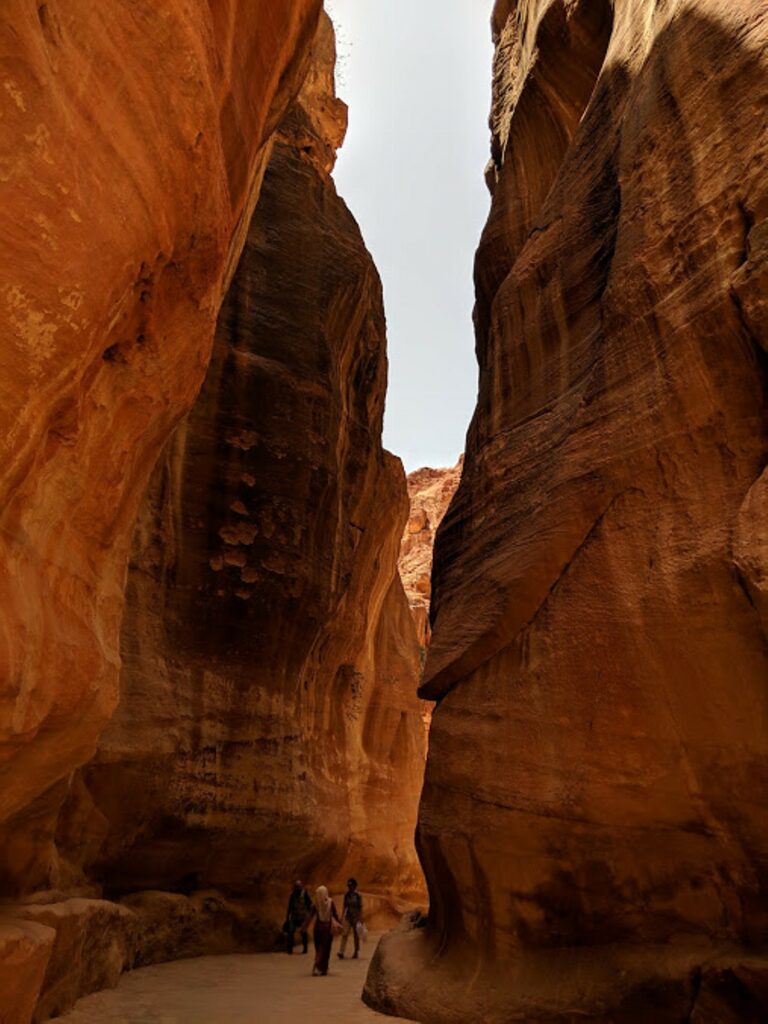
It is hot, but dry and the breeze is surprisingly comfortable. Besides exploring the archaeological structures, Petra turns out to be a hiking place – you can take trails that bring you up to fantastic views. One of the toughest is up to the Monastery – a mile each way up stairs and then back down again (and one of the challenges on the scavenger hunt – in fact, visiting early and doing the hike is worth 500 points).
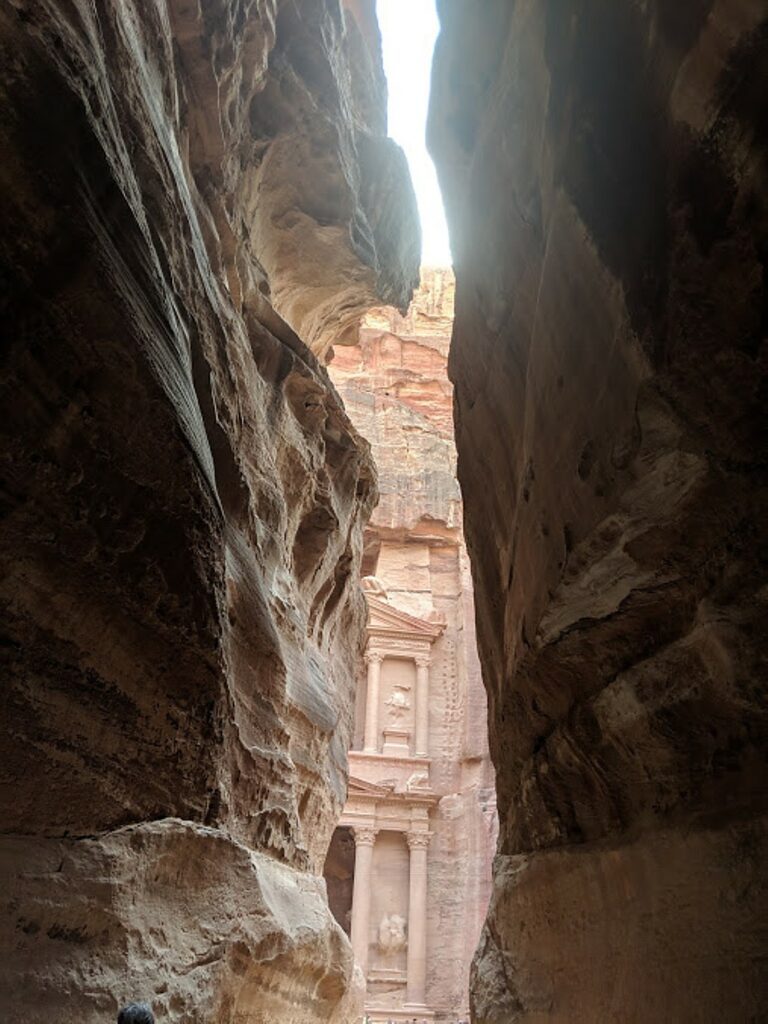
I decide to reserve that for the next day.
The city of Petra, aptly known as the Rose-Red City for the luscious color of the rock from which many of the city’s structures were carved, was the capital of the Nabataean Arabs, and is today one of the world’s most famous archaeological sites.
The Siq, the main road that leads to the city, starts from the Dam and ends at the Treasury. It is a rock canal 160 meters in length, 3 to 12 meters in width and reaches up to 80 meters in height. The main part of the Siq is created by natural rock formation and the rest is carved by the Nabataeans.

If you look carefully, you can see a channel carved from the rock to capture and even filter water – the secret to how Petra was sustained. At the start of the Siq the original Nabataean dams are visible, and these prevented flooding in the Siq and collected water for use.
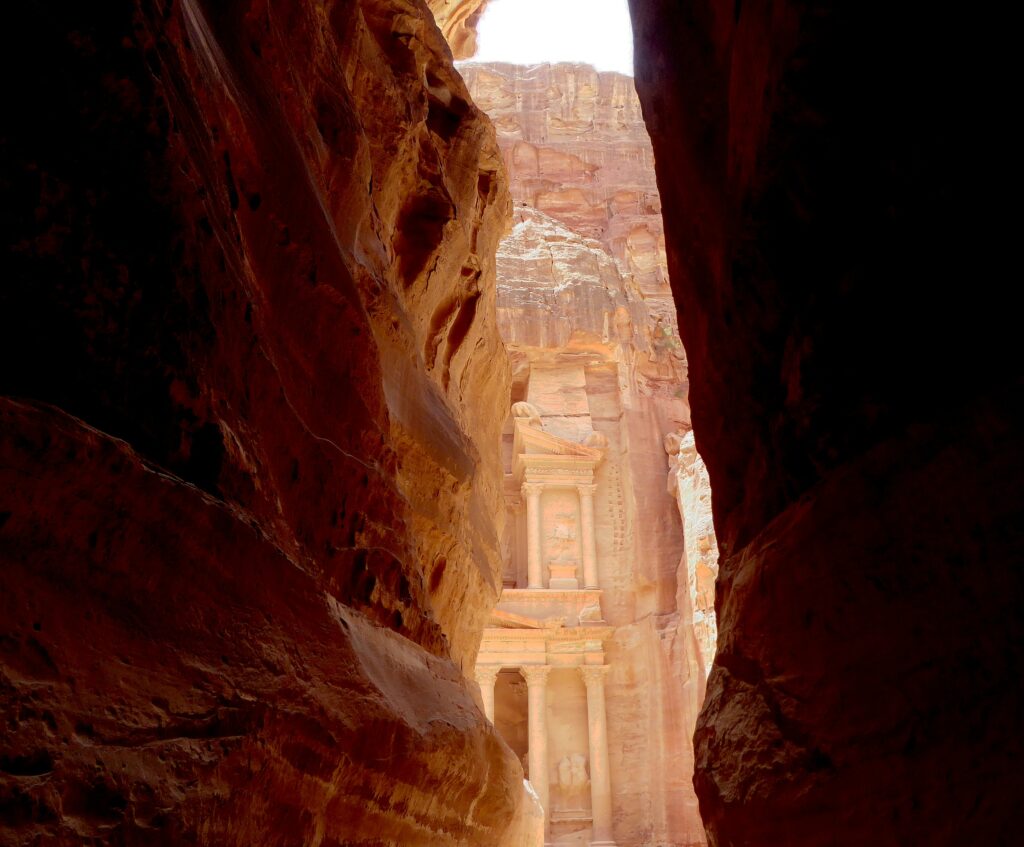
Then, through a narrow, curving break in the rock, you get your first teasing glimpse of The Treasury, just as Frederick Edwin Church painted it in 1874.

According to the website, www.visitpetra.jo, it is not known precisely when Petra was built, but the city began to prosper as the capital of the Nabataean Empire from the 1st century BC, which grew rich through trade in frankincense, myrrh, and spices (stalls sell the spices).
Petra was later annexed to the Roman Empire and continued to thrive until a large earthquake in 363 AD. The earthquake, combined with changes in trade routes (and politics), eventually led to the city’s downfall.

“The city was pretty much abandoned by the middle of the 7th century and lost to all except local Bedouins,” according to the website, www.visitpetra.jo. “But in 1812, Swiss explorer Johannes Burckhardt set out to rediscover Petra. He dressed up as an Arab and convinced his Bedouin guide to take him to the lost city. After this, Petra became increasingly known in the West as a fascinating and beautiful ancient city, and it began attracting visitors and continues to do so today.
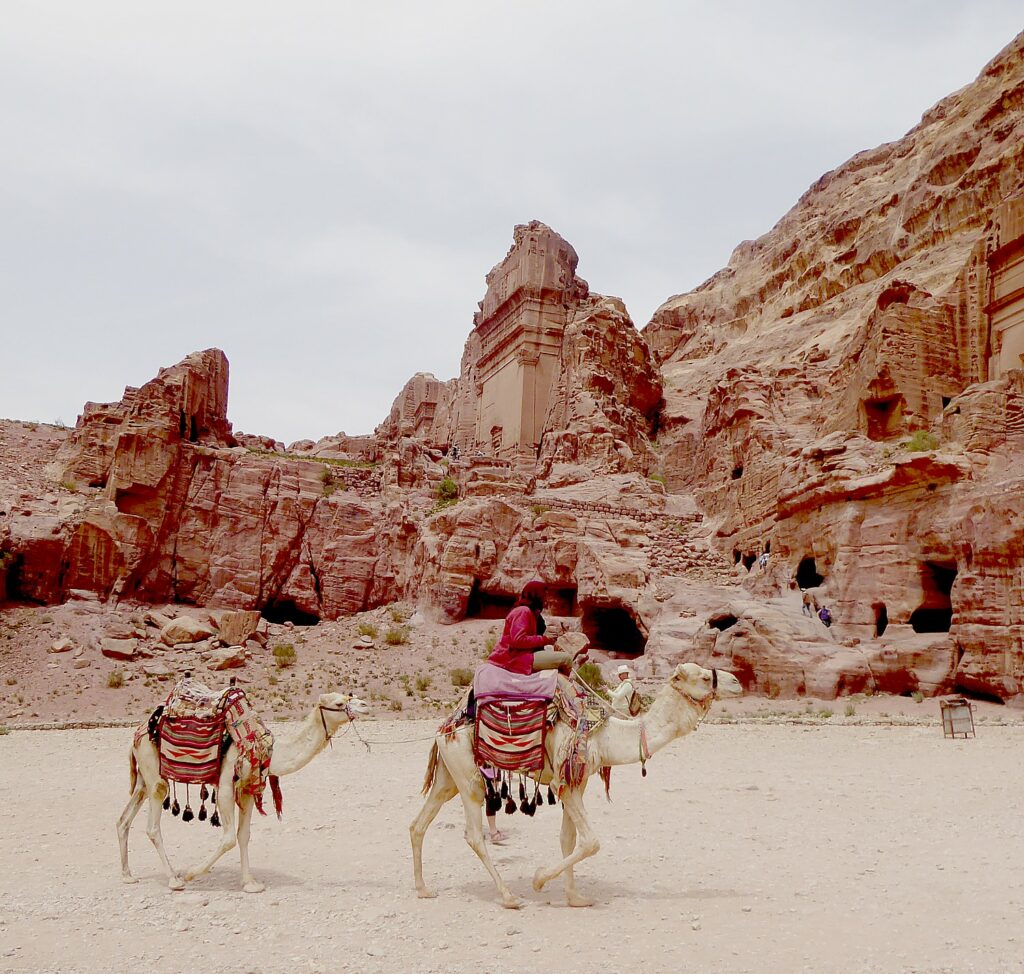
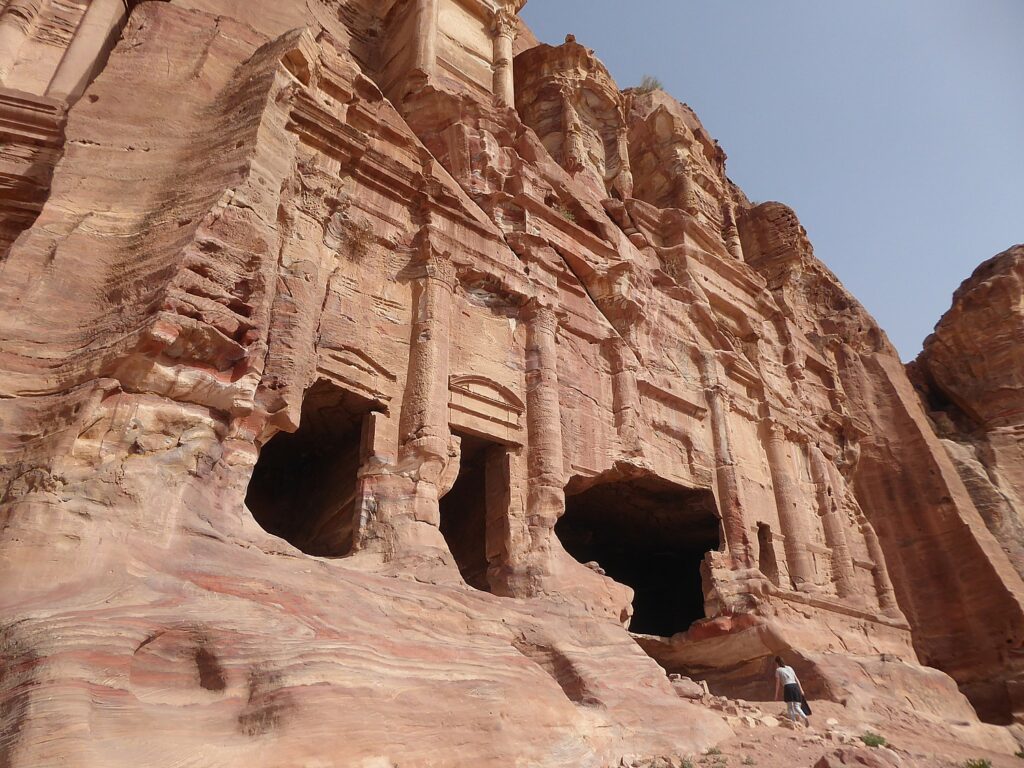
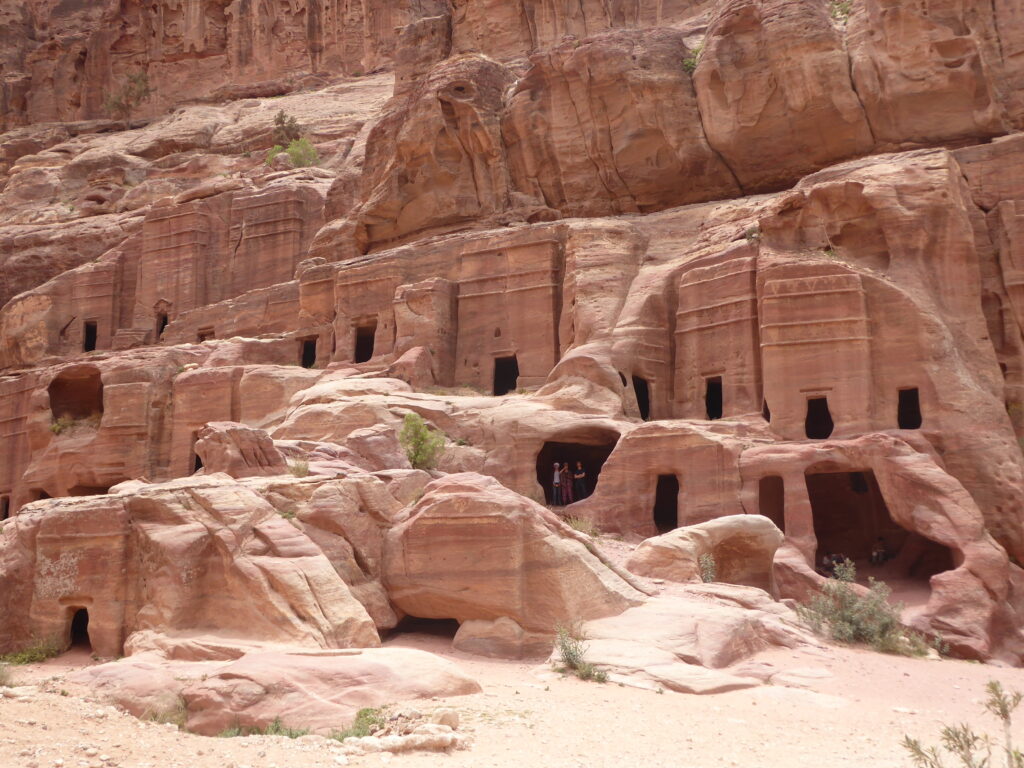
“The Nabataeans buried their dead in intricate tombs that were cut out of the mountain sides and the city also had temples, a theater, and following the Roman annexation and later the Byzantine influence, a colonnaded street and churches” the ruins of which we can explore.”

I climb the path up to the Royal Tombs and go into cavernous rooms – I can’t tell if it is the rock’s own configuration or whether the surface has actually been painted or carved to expose swirls of different colors and textures, but they are exquisite.
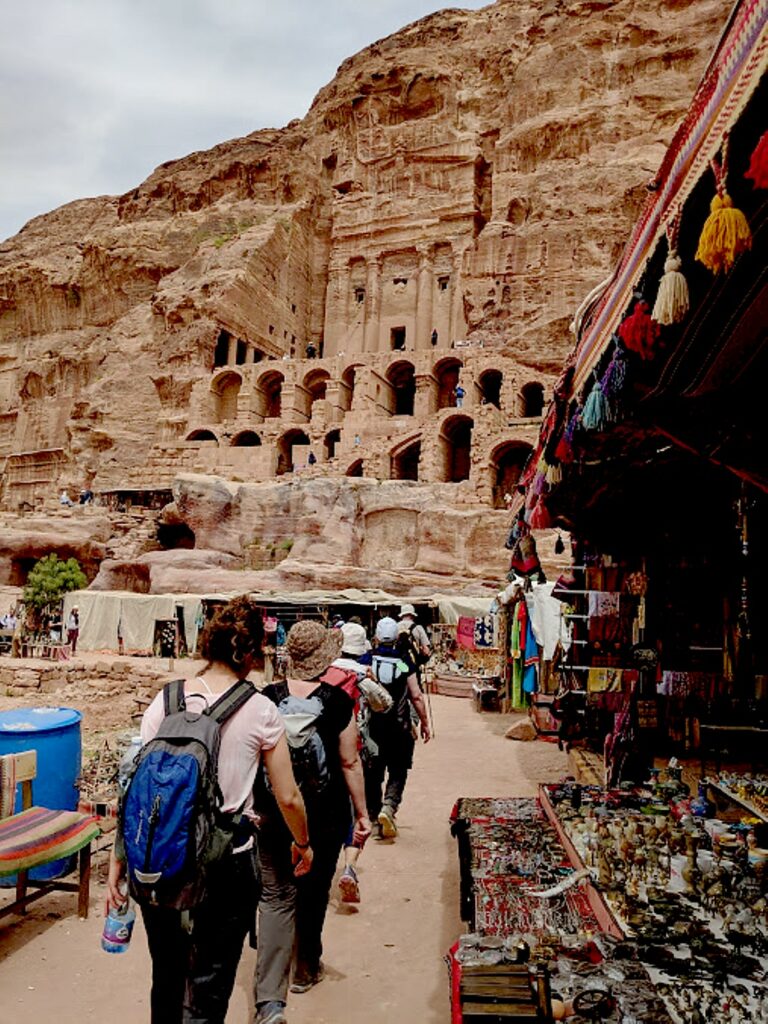
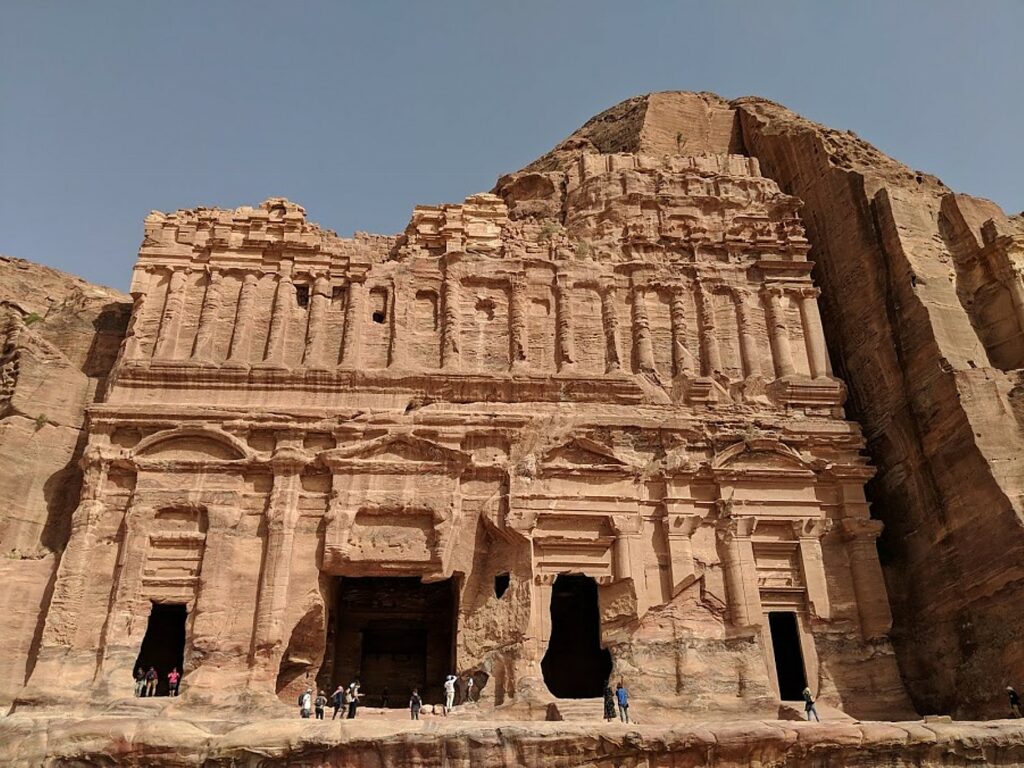
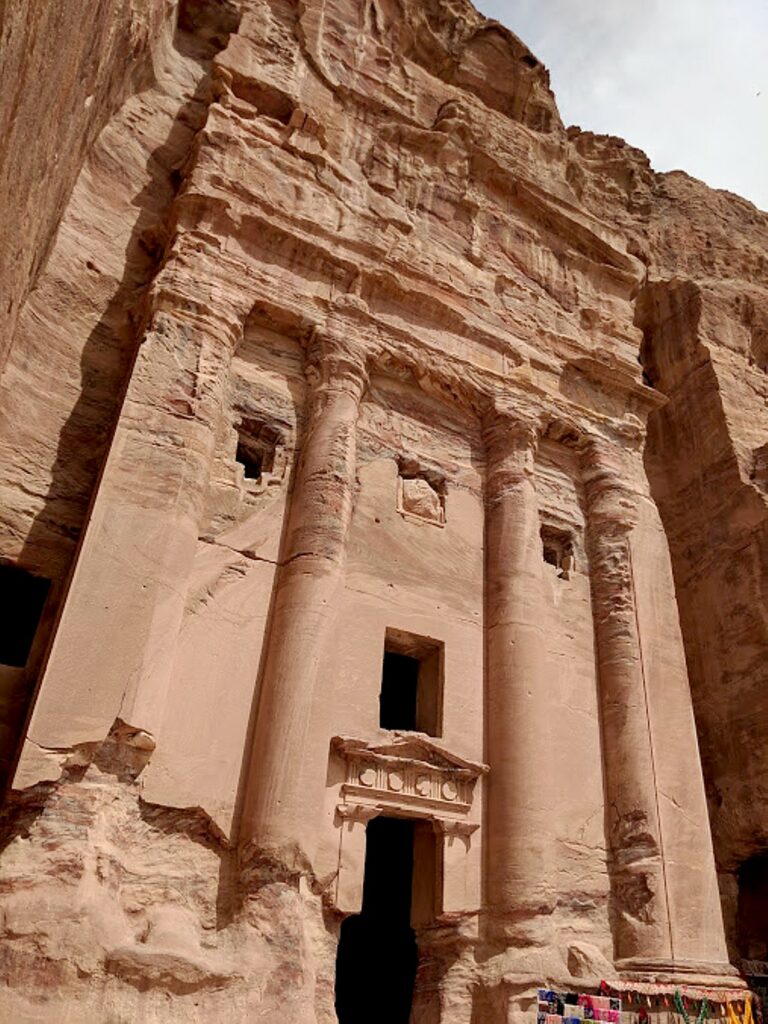
“In addition to the magnificent remains of the Nabataean city, human settlement and land use for over 10,000 years can be traced in Petra, where great natural, cultural, archaeological and geological features merge,” according to the website.
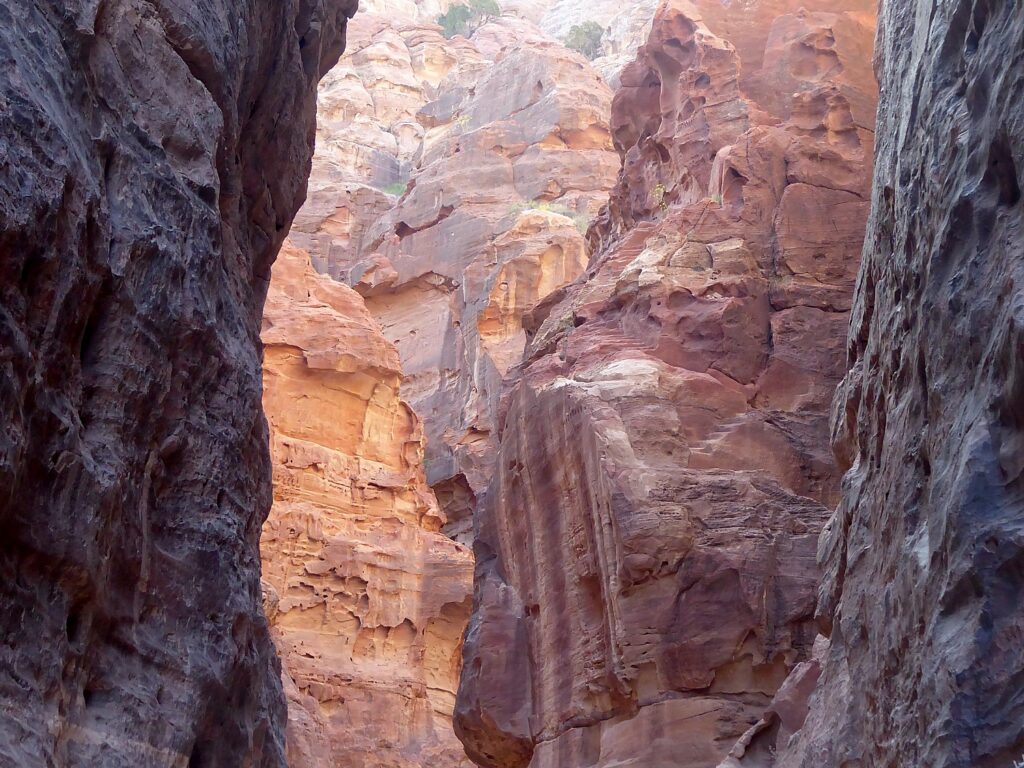
Walking back out through the Siq, you have to keep moving to the side to let pass the horse-drawn carriages which go through at quite a clip.
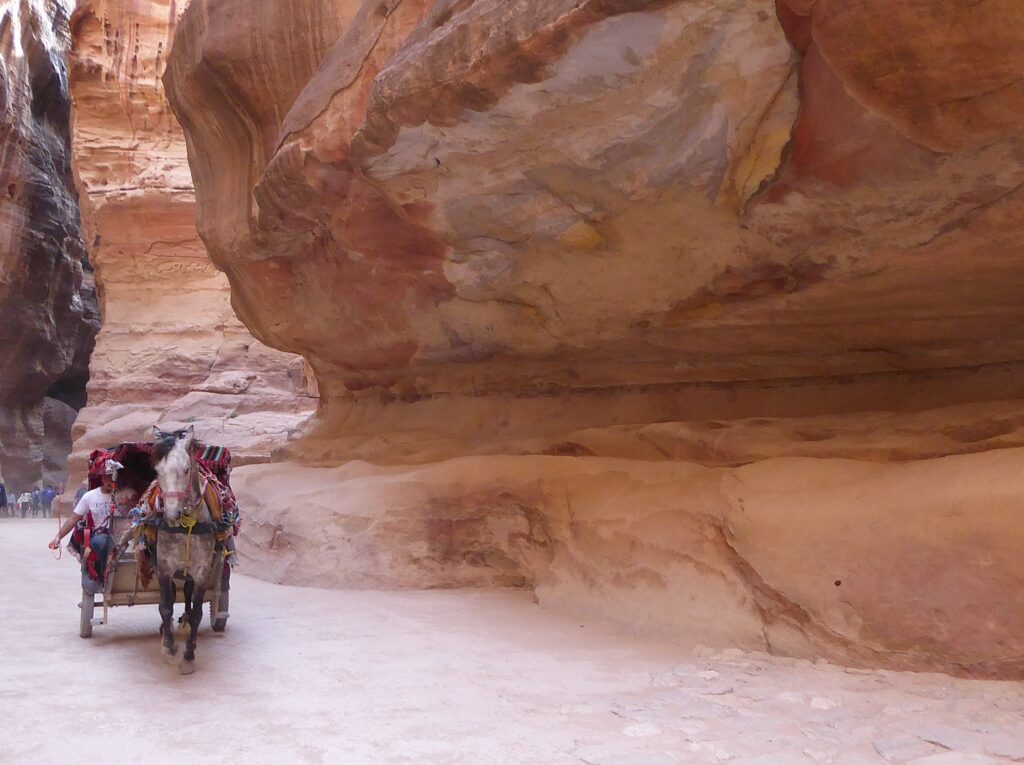
The park closes at about 6 p.m. and reopens at 8 pm for the 8:30-10:30 night program (it is operated separately and privately from Petra). I still have to get my pack, which I have left with the fellow at the CV Currency Exchange, just before you enter ($5 tip) and get to the hotel, which I had thought was within walking distance (0.7 mile), but turns out to be totally uphill. I take a taxi (negotiating the rate since I don’t have very much local currency).
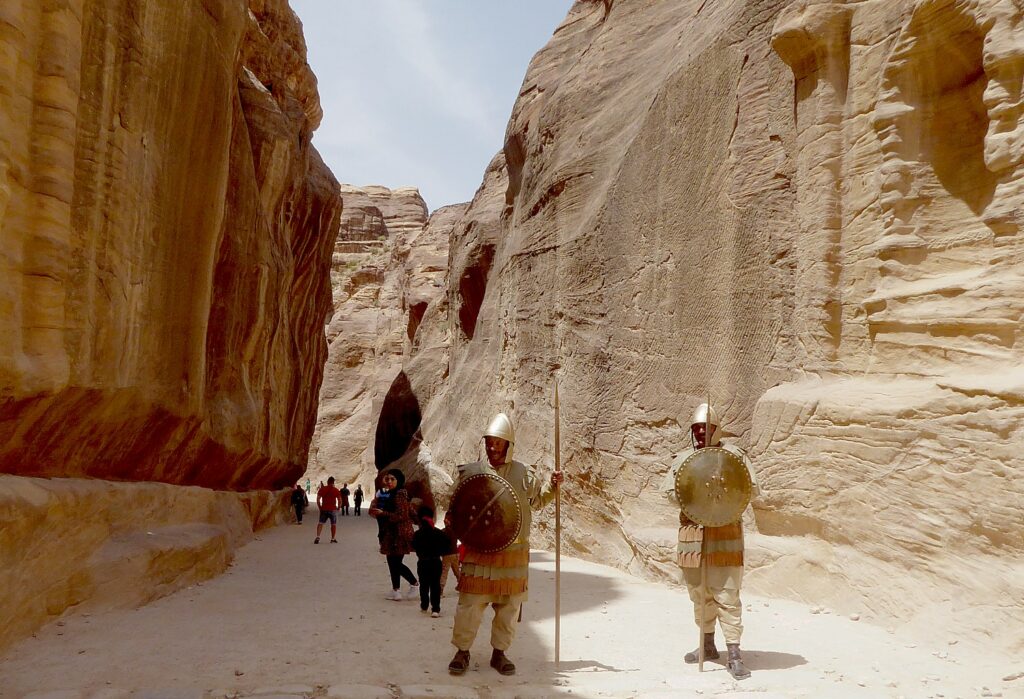
My el cheapo-supremo hotel (more of a hostel than a hotel), The Rose City Hotel, turns out to be exactly that – the nicest part is the name and the front entrance. When I am brought to my room, I think the fellow made a mistake and has brought me to a room under construction (or rather deconstruction) – plaster patches, exposed electrical outlet, rusting shower, cracked bathroom shelf, an “armoire” that is falling apart, only a small bed and a stool (not even a chair), slippers left for the bathroom that are too disgusting to contemplate putting on. Ah, adventure. But overall, clean and no bugs. So this will do for a night, I think, laughing to myself about my room at the five-star, ultra-hip, chic and luxurious W Hotel (which is like living in art, it is so creatively designed) I had left behind in Amman.

I head out just after 8 p.m., walking down the hill into the park again, where I join throngs of people making their way along the mile-long stony path illuminated by nothing more than lanterns and starlight, thinking how dramatic and wonderful. It turns out to be the best part of the evening.
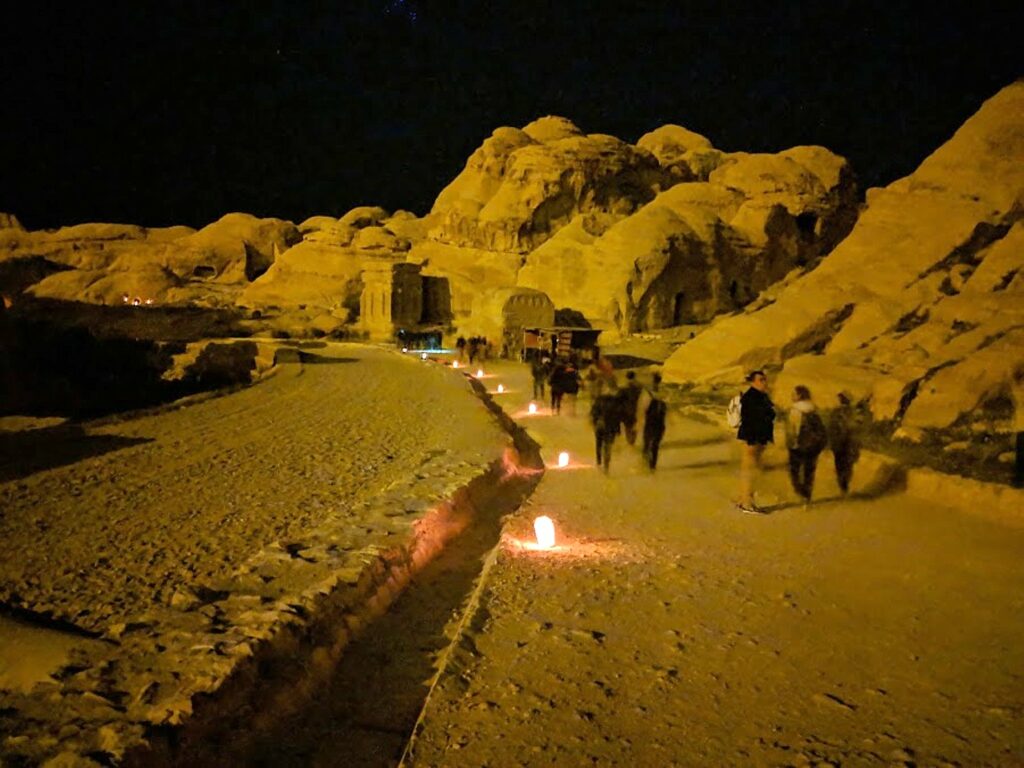
After 45 minutes of walking (it is dark in the cavern), I arrive at The Treasury where there are perhaps 1,000 people sitting on carpets. I stuff myself into a place. I am keen to reproduce the photo I had seen of the event, but The Treasury at this point is barely lighted at all. There is some traditional music, then a fellow sings, talks for a few minutes, and then garish neon-colored lights are projected against The Treasury, completely destroying the mood. And then it is over at 9:30 pm (not 10:30 p.m.). People start leaving, and I am totally exhausted, so I leave, too. I hike back up the hill to the hotel getting lost so a fellow very nicely leads me to where I need to go. I fall asleep to the meowing of feral cats just outside the window.

Early Morning Solitude at Petra
My overnight adventure is redeemed the next morning when I am able to return to the archaeological park as early as 6 a.m. The hotel proprietor has packed my breakfast in a baggie in the refrigerator. I take my pack with me and find a nice man at one of the refreshment stalls at the bus station who offers to hold it for me for the day.
When I arrive at Petra, who should I come upon at 6:14 a.m. but the Lawyers Without Borders team! What are the odds! (Literally on the run, so not to lose time, Zoe tells me of their amazing adventure in a tented camp about two hours away where they could get their scavenger points being photographed on a camel, so they were up at 4 a.m. and had to organize a taxi to get here by 6 a.m.). Rainey and Zoe have to literally race through Petra and do the strenuous hike up to the Monastery in order to earn their 500 Global Scavenger Hunt points.
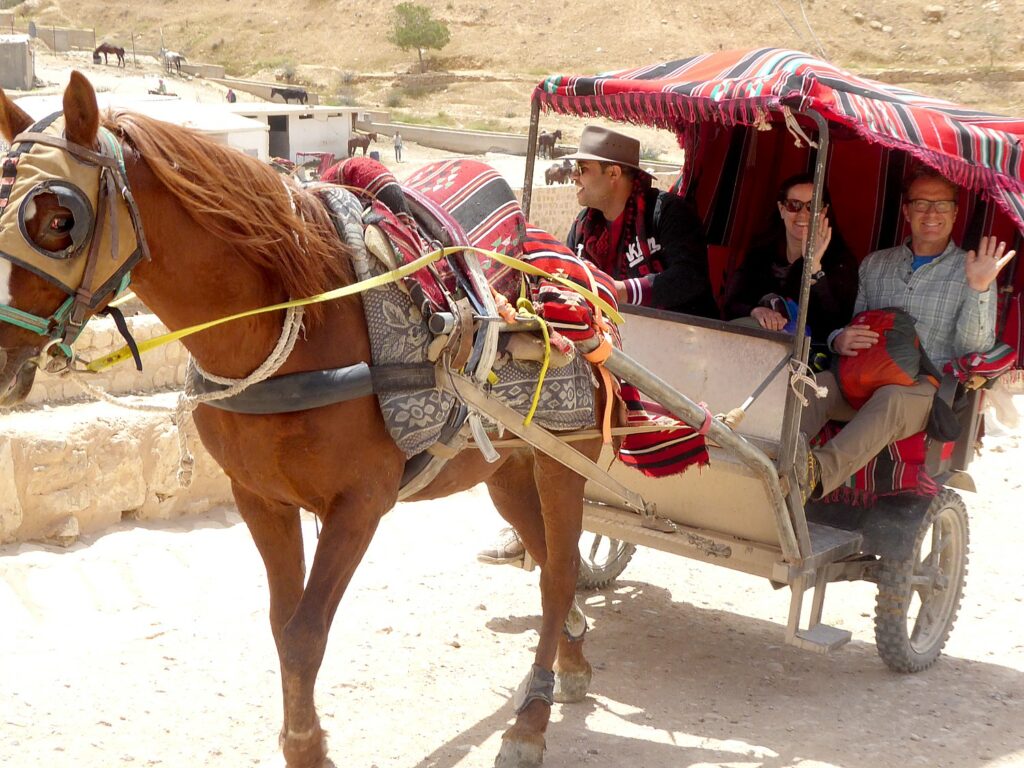
The Global Scavenger Hunt “Lazy Monday” team of Kathryn & Eric of California race to complete the scavenge challenge in Petra. © Karen Rubin/goingplacesfarandnear.com
I could be more leisurely because I am not trying to earn points. Walking through the caverns (some of the most exquisite scenes) is unbelievably peaceful at this hour – I am even the only one at some points. There are no horse-drawn carriages rattling through, none of the hoards of people stopping and posing for selfies. And once inside, there is perfect peace also at The Treasury – the camels perfectly positioned to re-create the 19th century paintings of the scene.
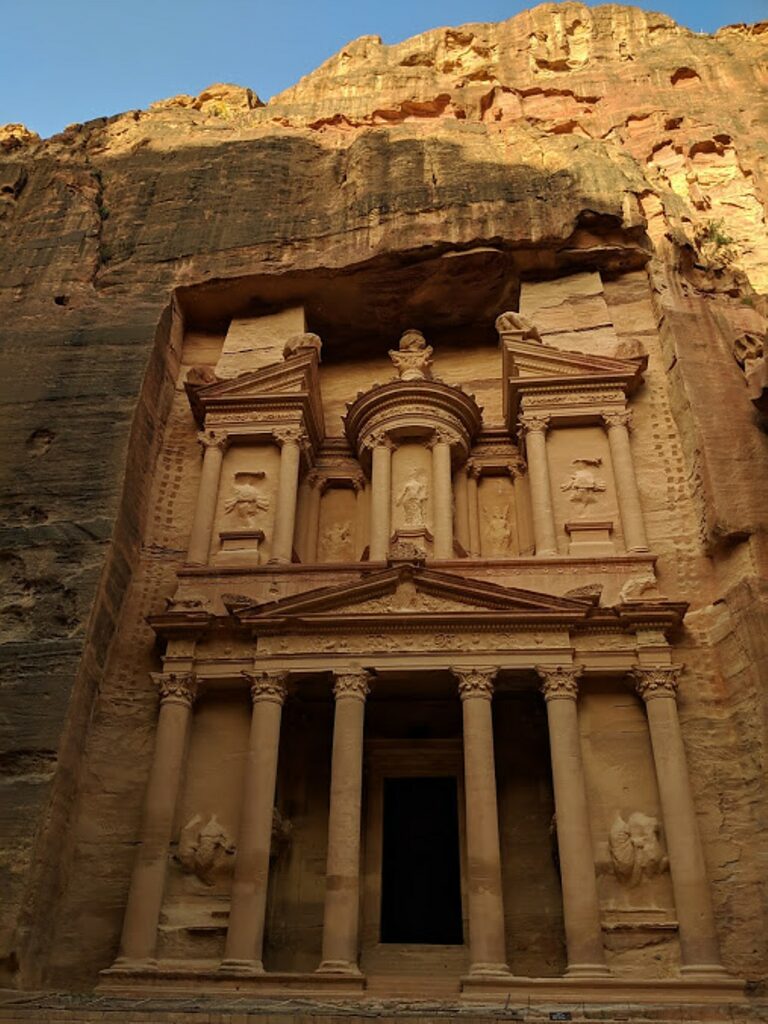
As soon as you arrive, though, you are swooped upon by a legion of guides. One guide offers to lead me on a trail that would take me to the overview of The Treasury (ranked moderate), but I am not feeling 100 percent and hope I will be able to hike the Monastery Trail if I take it slow.
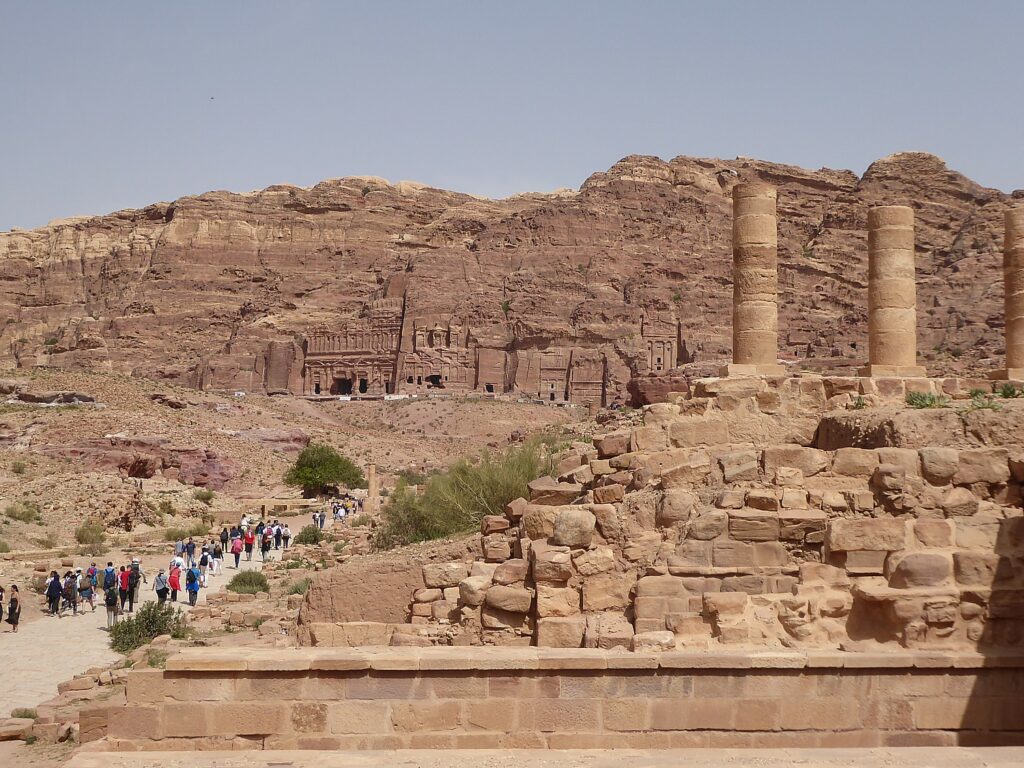
A word about the guides – they try to convince you that they will take you places you can’t go yourself, which is highly dubious– but though I don’t hire any, what I observe is that they are very knowledgeable, very considerate of their guests (in fact, it is difficult to become a guide – you have to take a test, be accepted, and then trained). The people who provide the camels, the horses, the donkeys (you can ride donkeys up to the Monastery), and the carriages work very hard (the animals work even harder). Later, though, I see guides leading people up the Monastery Trail that spend their time on their cell phone coordinating their next gig.
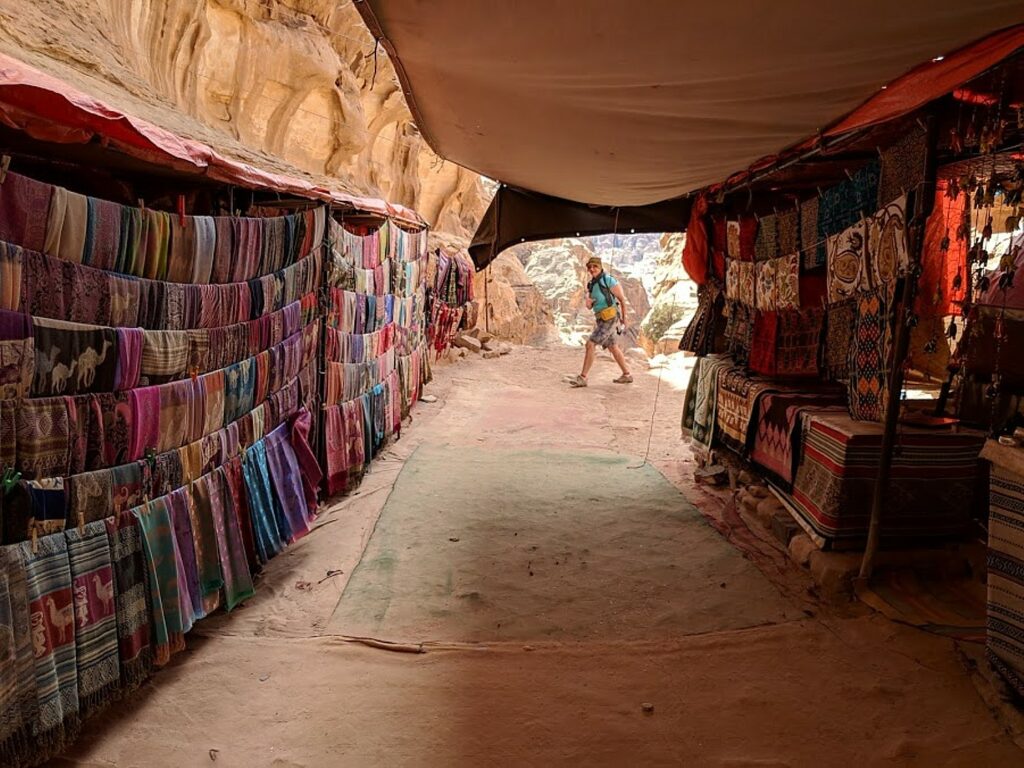
And all through are the souvenir stands (they actually look pretty good) – and you realize that Petra was a trading center, a stop along the vital caravan routes, and this is very likely what the scene would have looked like even then. And I am sure the experience was the same for the early European tourists 150 years ago, guides, merchants, donkeys, camels and all.
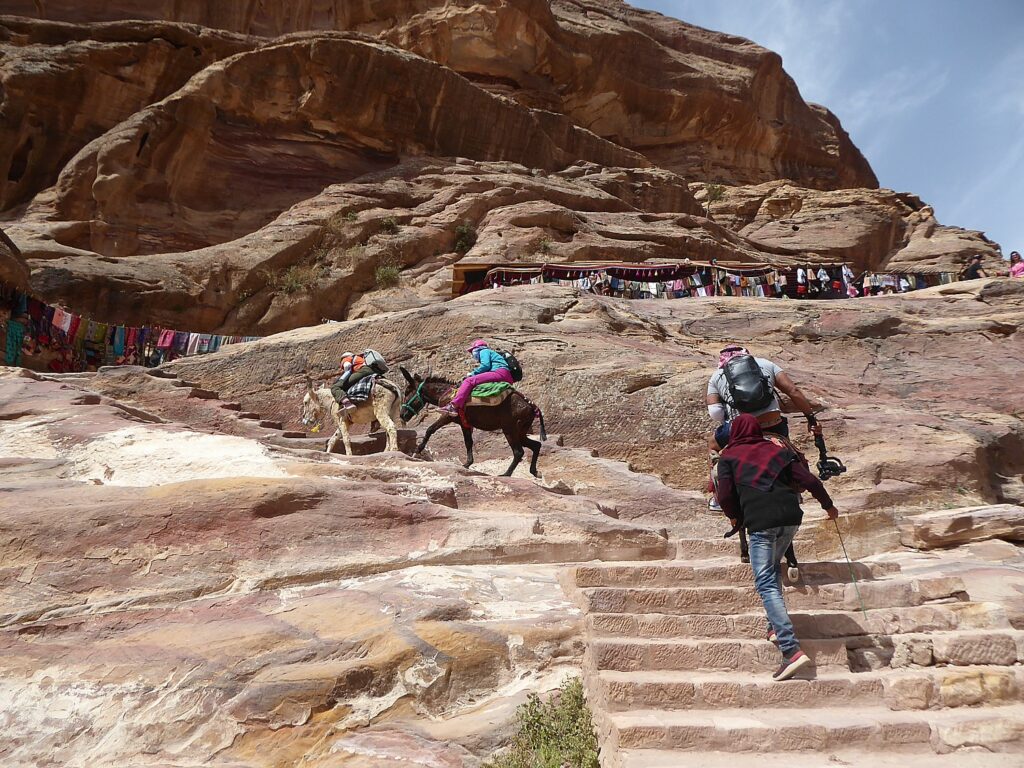
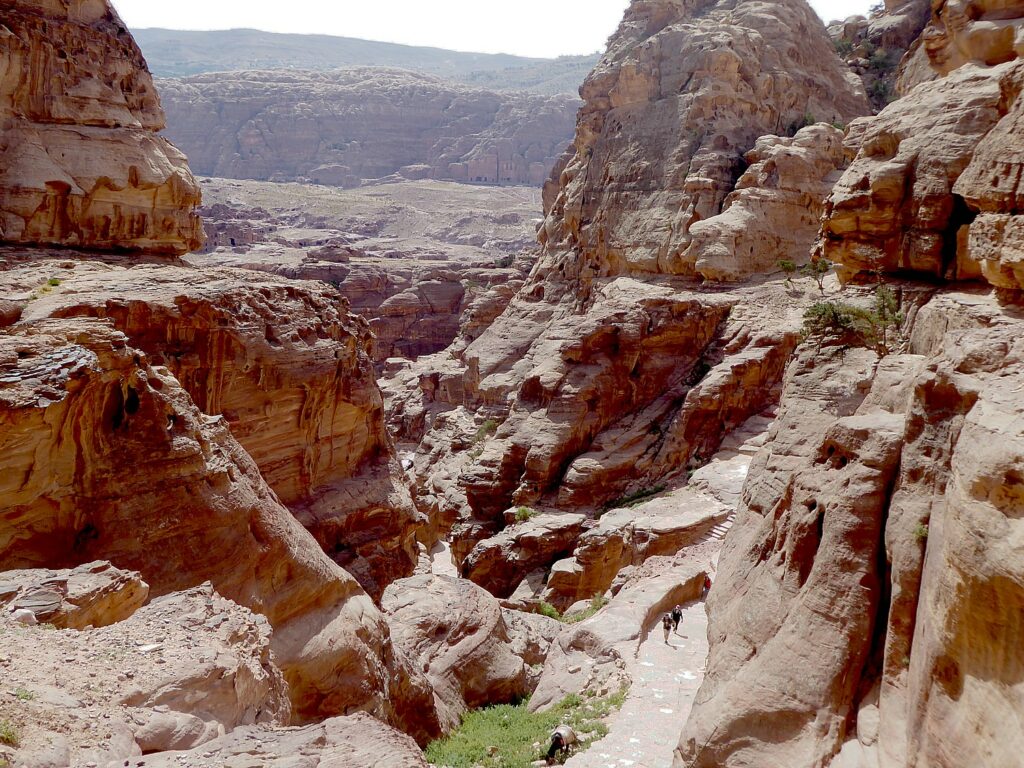
I walk through the park again, this time to hike the Monastery Trail at the other end of the park. I get some scouting information from people coming down and begin the steep ascent up stone steps. It is a very interesting hike not just because of the gorgeous stone contours and colors and the views back down, but because of the market stalls and refreshment stands set up along the way. (You can also take a donkey up, which means that hikers have to keep moving aside for the donkeys). I wish I had my hiking sticks with me (the hike reminds me of the Bright Angel trail up from the bottom of the Grand Canyon) – a fellow from Spain hiking with his mother, offers a hand when I trip (then we take a wrong turn and find ourselves scrambling over boulders, instead of climbing the stairs).
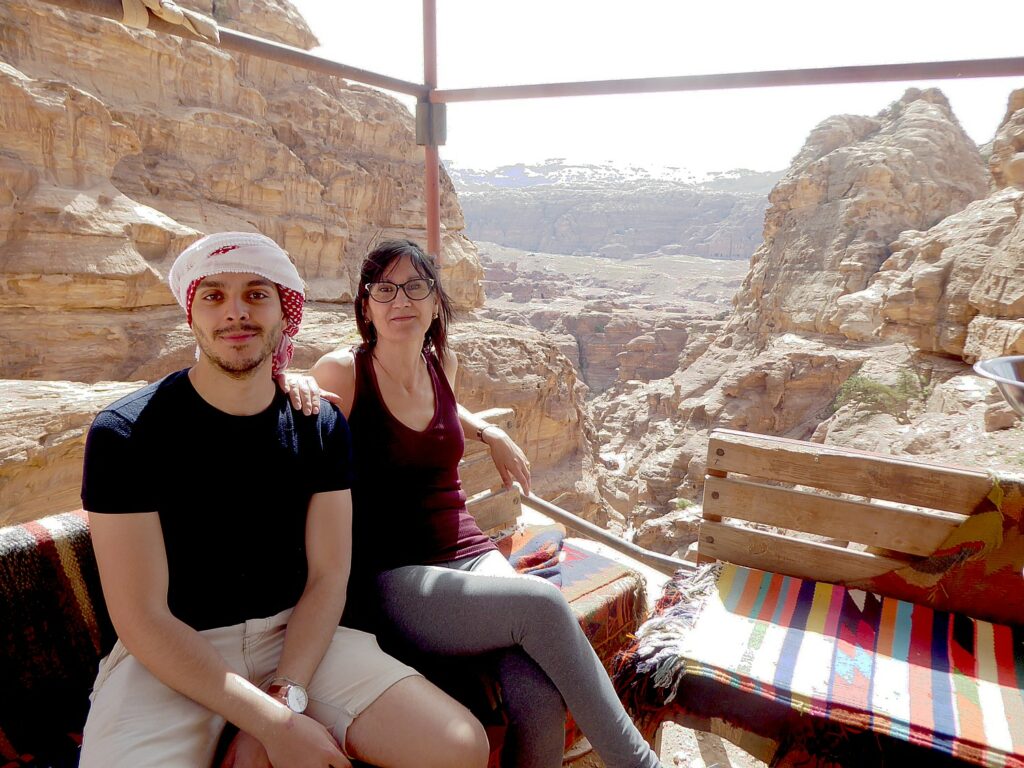
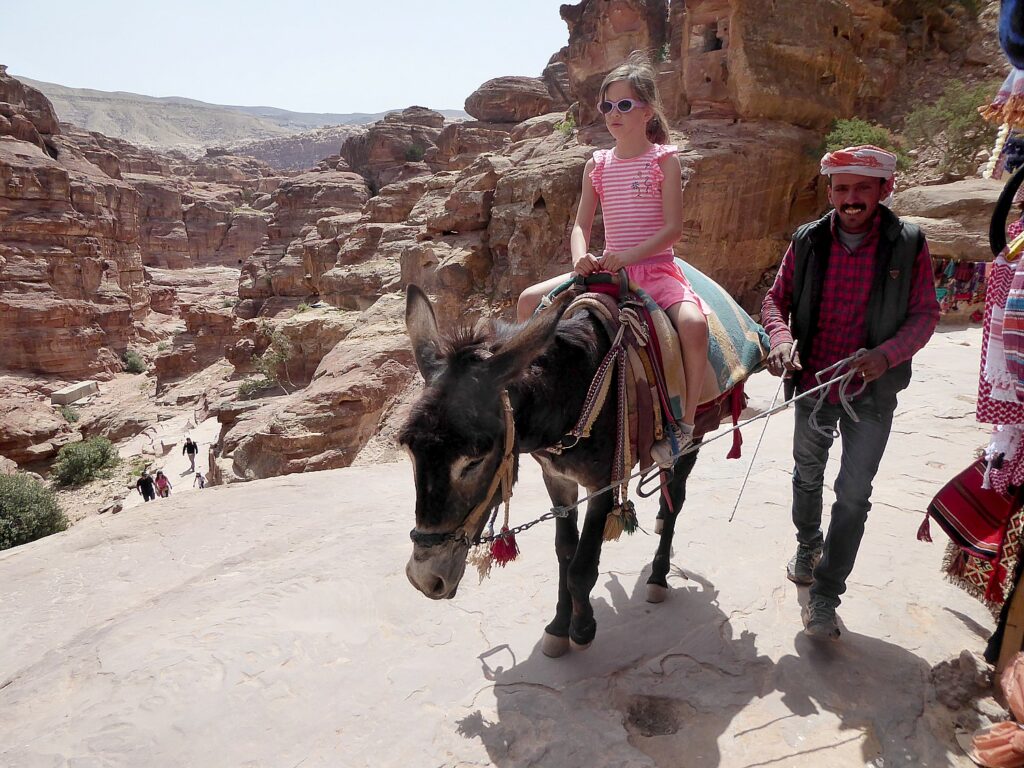

The Monastery proves to be a highlight – it is actually bigger than The Treasury – one of the largest structures carved out of a rock face (if I have that right). The hike is absolutely worth it and feels so satisfying when you make it to the top. There is a lovely rest stop at the top (as well as stalls improbably situated along the way and a refreshment stand picturesquely set about two-thirds up the trail with a stunning view).


But back down, I am exhausted and have several hours before the Jett Bus back to Amman (I expect to arrive at the W Hotel after the 8 p.m. deadline for the Global Scavenger Hunt teams but have informed Bill that the bus likely won’t be back until after 9 p.m., and I won’t miss a flight to our next destination, will I?)

I have my plan: first I linger at the Basin Restaurant at the entrance to the Monastery Trail, a veritable oasis, where I sit outside under trees and have refreshment. I regain some strength and wander some more. At this point, I realize what a phenomenal experience I have had in the early morning when I had Petra to myself when I see coming at me some 2,000 passengers off the MSC ship, another 2,000 off a second MSC ship, and hundreds more off a Celebrity cruise that look like an invading army. Each group is led by a guide holding high a numbered sign (I spot the number 50) for their group.
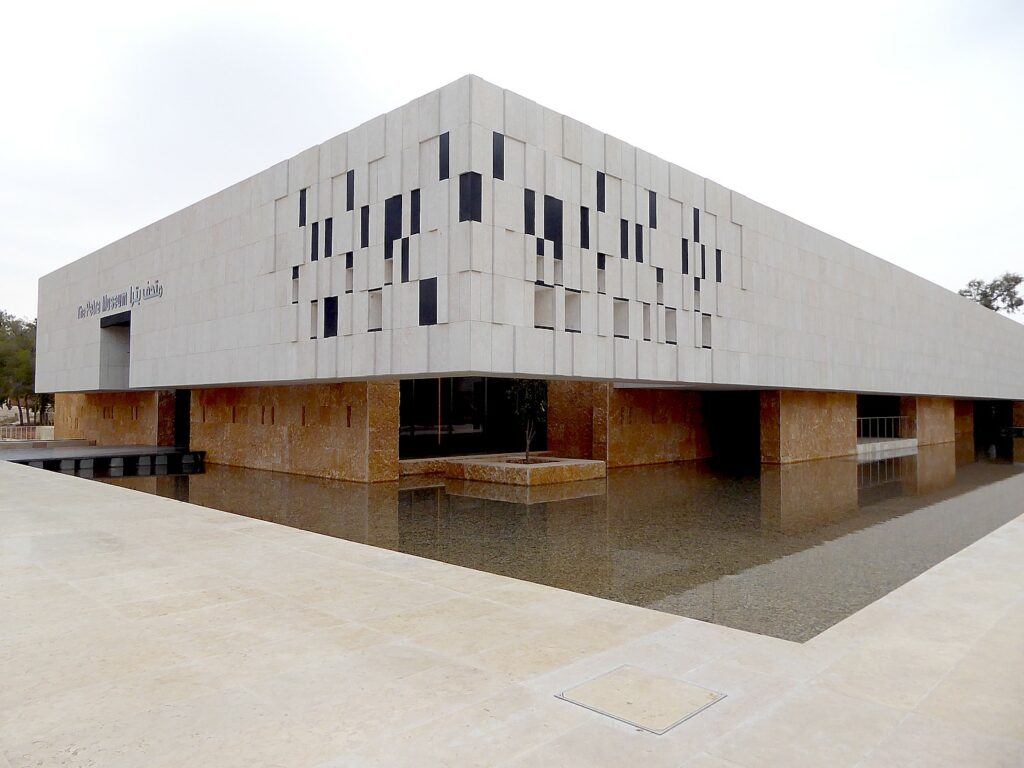
My next plan is to stop into the Petra Guest House, which is located right at the entrance to the park. (This is the hotel I would recommend for those who want to come overnight in order to experience Petra in the early morning – it is very comfortable, pleasant and moderate price).
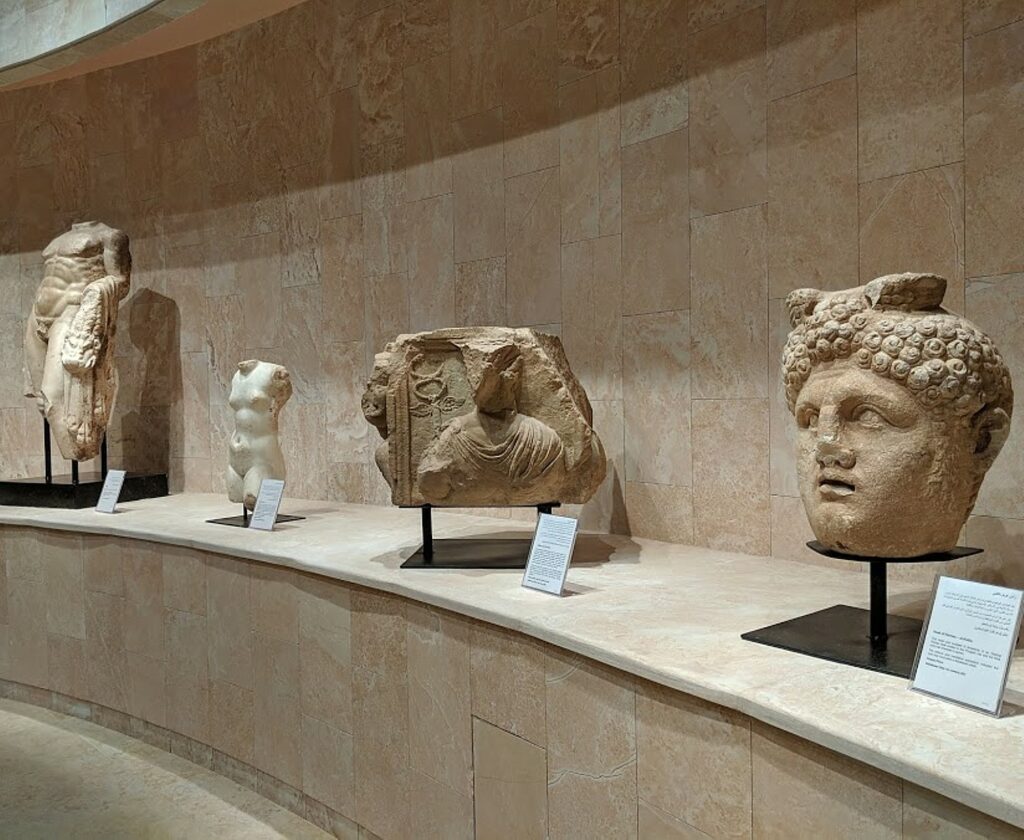
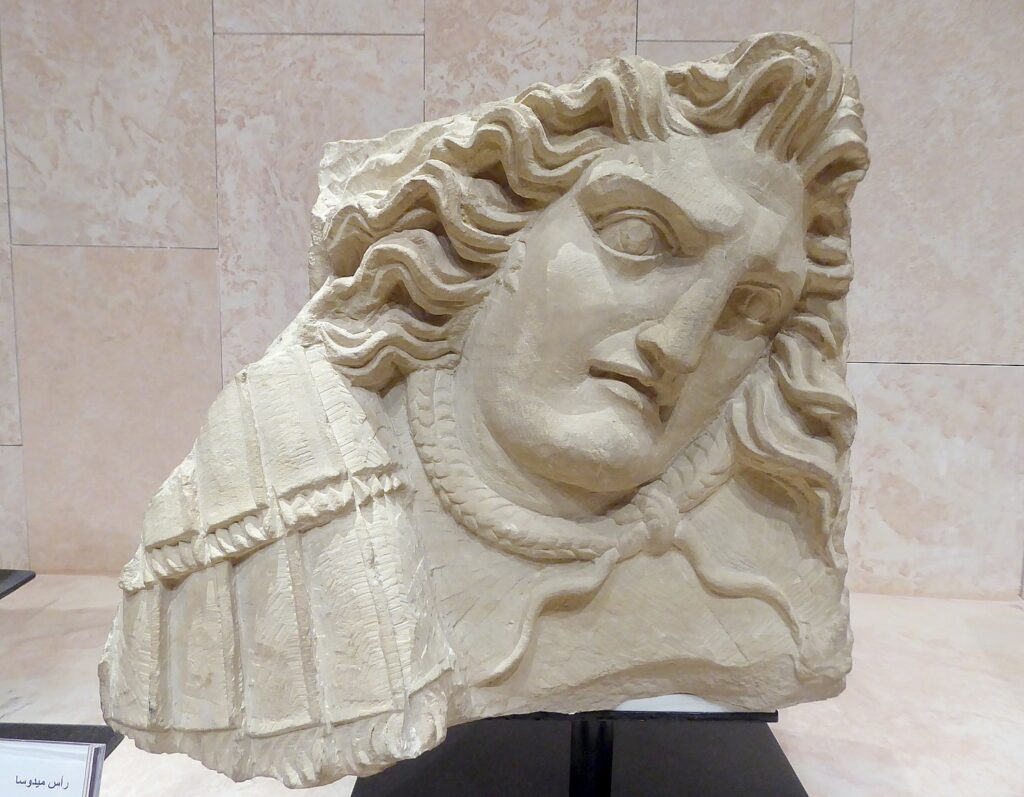

I have left an hour to visit the newly opened Petra Museum, sandwiched between the Visitor Center and the Bus Station (perfect!). It offers an outstanding exhibit (curiously Japan was a major contributor) – with some 250 artifacts and displays that explain extremely well how Petra developed, the Nabateans, how they grew to power first by controlling water through ingenious engineering and the main trade route, the King’s Highway, that linked three kingdoms. Artifacts including art as well as everyday materials going back to the Stone Age are on display; there are excellent videos, graphics, displays that are engaging and informative.
Petra was designated a World Heritage Site on Dec. 6, 1985 and Smithsonian Magazine named Petra one of the 28 places you should visit them before you die.
(More visitor information from Petra Development and Tourism Region Authority, www.visitpetra.jo)
I board the Jett Bus (it is the first-class bus geared to foreign tourists) for the three-hour trip back.
More information on visiting Jordan at the Jordan Tourist Board, http://in.visitjordan.com/.
By the time I get back to Amman, I’ve missed the meeting when Bill Chalmers tells us our next stop on our Global Scavenger Hunt and departure time. My teammate texts the answer: Athens.
The Global Scavenger Hunt is an annual travel program that has been operated for the past 15 years by Bill and Pamela Chalmers, GreatEscape Adventures, 310-281-7809, GlobalScavengerHunt.com.
________
© 2019 Travel Features Syndicate, a division of Workstyles, Inc. All rights reserved. Visit goingplacesfarandnear.com, www.huffingtonpost.com/author/karen-rubin, and travelwritersmagazine.com/TravelFeaturesSyndicate/. Blogging at goingplacesnearandfar.wordpress.com and moralcompasstravel.info. Send comments or questions to [email protected]. Tweet @TravelFeatures. ‘Like’ us at facebook.com/NewsPhotoFeatures
